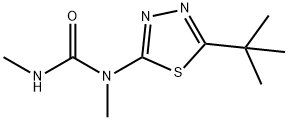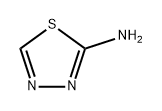1-(5-tert-Butyl-1,3,4-thiadiazol-2-yl)-1,3-dimethylurea
- CAS NO.:34014-18-1
- Empirical Formula: C9H16N4OS
- Molecular Weight: 228.31
- MDL number: MFCD00078732
- EINECS: 251-793-7
- SAFETY DATA SHEET (SDS)
- Update Date: 2024-12-18 14:15:30

What is 1-(5-tert-Butyl-1,3,4-thiadiazol-2-yl)-1,3-dimethylurea?
The Uses of 1-(5-tert-Butyl-1,3,4-thiadiazol-2-yl)-1,3-dimethylurea
Tebuthiuron is an nonselective broad spectrum herbicide used to control weeds, woody and herbaceous plants.
The Uses of 1-(5-tert-Butyl-1,3,4-thiadiazol-2-yl)-1,3-dimethylurea
Herbicide.
The Uses of 1-(5-tert-Butyl-1,3,4-thiadiazol-2-yl)-1,3-dimethylurea
Nonselective herbicide used to control herbaceous and woody plants on noncrop land.
Definition
ChEBI: Tebuthiuron is an organonitrogen heterocyclic compound and an organosulfur heterocyclic compound.
General Description
Colorless odorless crystals. Non corrosive. Used as an herbicide.
Reactivity Profile
A urea, thiadiazole derivative.
Agricultural Uses
Herbicide: Tebuthiuron is a broad-spectrum herbicide that is used to control weeds in non-cropland areas, range lands, rights-of-way and industrial sites. In grasslands and sugar cane it controls woody and herbaceous plants and weeds such as alfalfa, bluegrasses, chickweed, clover, dock, goldenrod and mullein. Not approved for use in EU countries[ 115]. Registered for use in the U.S.
Trade name
BRULAN®; BRUSH-BULLET®; E-103®; GRASLAN®; HERBEC®; HERBIC®; PERFLAN®; RECLAIM; SHA-105501®; SPIKE®; SPRAKIL®; TEBULAN®; TIUROLAN®
Environmental Fate
Soil. In microbially active soils, tebuthiuron is degraded via demethylation. The average
half-life in soil 12–15 months in areas receiving 60 inches of rainfall a year (Humburg et
al., 1989).
When tebuthiuron was applied to a rangeland at a rate of 0.84 kg/ha, 38% remained
after 21 months (Emmerich et al., 1984).
Groundwater . According to the U.S. EPA (1986) tebuthiuron has a high potential to
leach to groundwater .
Plant. Degrades in plants via N-demethylation and hydroxylation of the t-butyl
sidechain (Hartley and Kidd, 1987; Humburg et al., 1989).
Properties of 1-(5-tert-Butyl-1,3,4-thiadiazol-2-yl)-1,3-dimethylurea
| Melting point: | 161-164°C |
| Density | 1.2080 (rough estimate) |
| refractive index | 1.6390 (estimate) |
| storage temp. | 0-6°C |
| form | Solid |
| pka | 13.36±0.46(Predicted) |
| color | White to Light yellow |
| Water Solubility | 2.3g/L(temperature not stated) |
| λmax | 255nm(lit.) |
| Merck | 14,9095 |
| BRN | 527479 |
| Exposure limits | LC50 (96-hour) for bluegill sun?sh 112 mg/L, rainbow trout 144 mg/L, gold?sh
and fathead minnow >160 mg/L (Hartley and Kidd, 1987); acute oral LD50 for rats 644
mg/kg (Ashton and Monaco, 1991). |
| CAS DataBase Reference | 34014-18-1(CAS DataBase Reference) |
| NIST Chemistry Reference | Tebuthiuron(34014-18-1) |
| EPA Substance Registry System | Tebuthiuron (34014-18-1) |
Safety information for 1-(5-tert-Butyl-1,3,4-thiadiazol-2-yl)-1,3-dimethylurea
| Signal word | Warning |
| Pictogram(s) |
 Exclamation Mark Irritant GHS07  Environment GHS09 |
| GHS Hazard Statements |
H302:Acute toxicity,oral H410:Hazardous to the aquatic environment, long-term hazard |
| Precautionary Statement Codes |
P273:Avoid release to the environment. |
Computed Descriptors for 1-(5-tert-Butyl-1,3,4-thiadiazol-2-yl)-1,3-dimethylurea
New Products
Tert-butyl bis(2-chloroethyl)carbamate (S)-3-Aminobutanenitrile hydrochloride N-Boc-D-alaninol N-BOC-D/L-ALANINOL N-octanoyl benzotriazole 3,4-Dibenzyloxybenzaldehyde 4-Hydrazinobenzoic acid 1,1’-CARBONYLDIIMIDAZOLE R-2-BENZYLOXY PROPIONIC ACID 3-NITRO-2-METHYL ANILINE 4-IODO BENZOIC ACID 4-HYDROXY BENZYL ALCOHOL 4-(3-chloropropyl)morpholine phenylhydrazine hydrochloride (2-Hydroxyphenyl)acetonitrile 4-Bromopyrazole 5-BROMO-2CYANO PYRIDINE 5,6-Dimethoxyindanone 5-broMo-2-chloro-N-cyclopentylpyriMidin-4-aMine 4-methoxy-3,5-dinitropyridine 2-(Cyanocyclohexyl)acetic acid 2-aminopropyl benzoate hydrochloride 1-(4-(aminomethyl)benzyl)urea hydrochloride tert-butyl 4- (ureidomethyl)benzylcarbamateRelated products of tetrahydrofuran








You may like
-
 Tebuthiuron CAS 34014-18-1View Details
Tebuthiuron CAS 34014-18-1View Details
34014-18-1 -
 Tebuthiuron CAS 34014-18-1View Details
Tebuthiuron CAS 34014-18-1View Details
34014-18-1 -
 (9H-fluoren-9-yl)methyl (2,5-dioxopyrrolidin-1-yl) carbonate 82911-69-1 98.0%View Details
(9H-fluoren-9-yl)methyl (2,5-dioxopyrrolidin-1-yl) carbonate 82911-69-1 98.0%View Details
82911-69-1 -
 13057-17-5 95.0%View Details
13057-17-5 95.0%View Details
13057-17-5 -
 4-bromoaniline 106-40-1 99.0%View Details
4-bromoaniline 106-40-1 99.0%View Details
106-40-1 -
 1421517-99-8 99.0%View Details
1421517-99-8 99.0%View Details
1421517-99-8 -
 5-bromo-2-chlorobenzoic acid 99.0%View Details
5-bromo-2-chlorobenzoic acid 99.0%View Details
21739-92-4 -
 15761-38-3 97.0%View Details
15761-38-3 97.0%View Details
15761-38-3